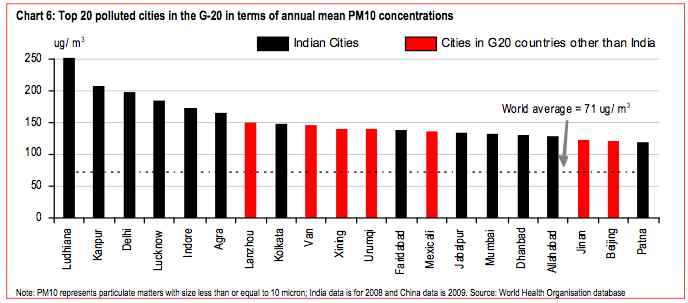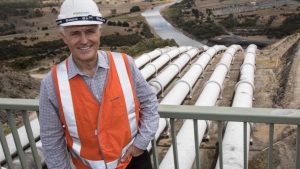As the IPCC report pointed out on the weekend, the move to cut air pollution, and increase energy security, will be high on the policy priority list for many emerging economies.
This is already playing out in China, whose well documented pollution problems have long dominated news feeds. But a new report has pointed the finger at India, declaring that the subcontinent’s coal habit has helped transform it into one of the world’s most polluted countries, with its capital, Delhi, now ranked worse than China’s Beijing.
“India is one of the most polluted countries globally and the situation appears to be worsening,” says the HSBC report India gasps for air, which names road transport and coal as the most significant contributors to the problem.
The report, published last week, cites a recently released World Bank study which found that India housed 13 of the 20 most polluted cities of the G20 countries, a situation it estimated was costing India $US80 billion a year.
“Of the 167 cities monitored for air pollution in 2010, 50 per cent reported critical levels of air pollution… when compared with the Indian standard, with another 28 per cent reporting high levels,” said the report.
“Amongst the top 20 most polluted cities globally, 13 are from India with the capital, Delhi, occupying the third position (compared to Beijing, at 19th). Only two cities in the country, Kochi and Coimbatore, met the national ambient air quality standards in 2011.”
“Air pollution in Delhi is worse than Beijing,” says the report, noting that particulate matter emission levels in Delhi have surged more than 70 per cent during 2007- 2013, compared to a 27 per cent decline in Beijing. “However Beijing is currently taking more action to manage pollution than Delhi,” it says.
India’s coal industry, especially the energy-intensive sectors with their high reliance on coal, is a major source of air pollution, says the report, noting that domestically sourced coal tended to be low on calorific value and high in ash content (35-50%), implying low thermal efficiency and high emission intensity.
This combined with poor emissions standards from the country’s coal power plants, which significantly lag other key countries, “will further worsen the country’s air quality situation,” says the report.
But, in keeping with the IPCC’s predictions, HSBC says it expects India’s pollution problem to be addressed in the near future, with the Supreme Court of India soon likely to implement a second phase of regulations on air pollution, including more stringent guidelines for coal-generating power plants and other polluting industries.
And the likelihood of such reform would increase significantly should Narendra Modi, leader of India’s Bharatiya Janata Party, win the general election that is currently underway and will end in mid-May.
As we wrote last month, a recent Bloomberg interview with the election front-runner has revealed Modi is not a fan of coal, but rather a proponent of clean energy, having pioneered India’s first incentives for large-scale solar power in 2009.
All this – along with the increasingly inconvenient implications of climate change – is bad news for Australia’s coal industry, whose ambitious growth and export plans, as we wrote in 2012, have been partially “built on the apparently unshakeable belief that coal can provide the only solution to the rampant energy needs of India – one the one of the world’s two fastest growing energy markets.”
Add to that HSBC’s findings last year that wind energy is already cost competitive with new-build coal capacity in India, with solar likely to follow suit sometime between 2016-18, and you have what looks like an increasingly unfriendly environment for fossil fuels.
But there is hope for coal yet, and it comes in the form of federal environment minister, Greg Hunt.
“Coal will be used for decades and decades more,” Hunt told Sky News on Monday night, in response to the IPCC report’s findings. “What I do think will change is the emissions from it and that is the critical thing…
“What I think will happen is this … we will be able to use coal and gas in a dramatically more efficient way, with dramatically lower emissions … that will happen over the coming decade as we make real progress, including cleaning up our brown coal power stations, with drying gasification and capturing, not for storage … but capture and reuse.”
The race is on.








